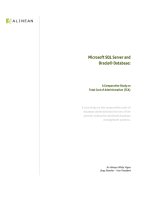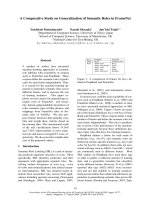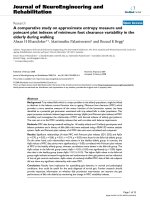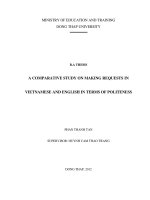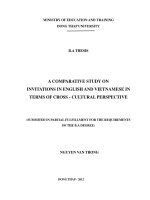A COMPARATIVE STUDY ON PHILOSOPHY OF MATHEMATICS EDUCATION IN CHINA AND INDIA
Bạn đang xem bản rút gọn của tài liệu. Xem và tải ngay bản đầy đủ của tài liệu tại đây (1.59 MB, 18 trang )
<span class="text_page_counter">Trang 1</span><div class="page_container" data-page="1">
The present study examines the philosophy of mathematics education in India and China. The methodology of the study is an interpretive and analytical study of documents. The followings are the common questions asked in philosophy of mathematics education: What is mathematics? What is learning mathematics? What is teaching mathematics? What are the aims and purposes of teaching and learning mathematics? How does mathematics relate to society? What is the status of mathematics education as knowledge field? This study tries to present the different schools of philosophies of mathematics and philosophy of mathematics education existing in India, China. The study also tries to the find the answer to the question: is there any global philosophy of mathematics education?
<i><b>Keywords: Mathematics education, philosophy of mathematics, philosophy of mathematics </b></i>
education, Jainism, Buddhism, Confucianism, Constructivism, Zeroism
<b><small>1.</small> Introduction</b>
Philosophy of mathematics has immense impact on mathematical activities. It helps the teacher to select the strategy to teach mathematics and affects teaching learning process. Zeng (1994) explicitly stated that there exists a close relationship between philosophy of mathematics and philosophy of mathematics education (PME). Philosophical views and epistemological theories related to mathematics bear a significant influence on mathematics education. Mathematics has been being developed in different countries in different ways and in different pace. Plofker (2009) offered an up-to-date and coherent narrative for the development of mathematics in India. Li and Du (1987) established a societal setting providing contemporary mathematics education procedures prevailing in China. Li and Du (1987) presented splendidly the accomplishments of Chinese mathematics.
</div><span class="text_page_counter">Trang 2</span><div class="page_container" data-page="2">Each country has its own tradition of mathematics and philosophy of mathematics.The comparative study on philosophy of mathematics education between India and China is an endeavour to promote and develop a broad understanding about the problems, challenges and emerging issues of philosophy of mathematics education in India, and China.
<b><small>2. </small>Literature review</b>
Philosophy of mathematics education (PME) has been influenced by many theories such as Wittgenstein's philosophy of mathematics (Wittgenstein, 1953; 1956), Piaget's theories of cognitive development (Piaget, 1936), social constructivism (Vygotsky, 1978), radical constructivism (Glasersfeld 1989). PME is also influenced by the work of Lakatos (1976) as observed in the social constructivists' preference for the “Lakatosian” conception of mathematical certainty as being subject to revision over time. (Ernest, 1991) to put forth a fallible and non-Platonist viewpoint about mathematics. The absolutist philosophy of mathematics is challenged by many philosophers like Putnam (2000) stated that “mathematics is a corrigible, fallible and transmuting social product”.
Steiner (1987) studied philosophical and epistemological aspects of mathematics as well as mathematics education. Ernest (1991) presented a summary of 'Logicism', 'Formalism', and 'Constructivism' in his book “Philosophy of mathematics education”. Ernest (1991) also presented a new philosophy of mathematics that he calls 'social constructivism'. The editorial book entitled:” Math Worlds: Philosophical and Social Studies of Mathematics and Mathematics Education” ( Restivo et al. , 1993) presented different issues of philosophy of mathematics, philosophical perspectives of foundations of mathematics, social and political perspectives of mathematics, etc. Zeng (1994) studied PME and their interaction with philosophy of mathematics. USA emphasised on problem solving, the psychology of mathematics learning, and social- cultural approach to mathematics education (Zeng, 1994). Zeng (1994) discussed the theoretical foundations of mathematics education that includes the view of mathematics and the analysis of the nature of mathematical learning and aim of mathematics education in special reference to USA. In India, Raju (2007) presented an
<i>alternative philosophy of mathematics and proposed a new PME in his book “Cultural </i>
<i>Foundations of Mathematics”. Raju (2007) heavily opposed the history of mathematics, which </i>
is Eurocentric. In his work, Raju (2007) favoured the traditional Indian notion of pramana
</div><span class="text_page_counter">Trang 3</span><div class="page_container" data-page="3">(validation) based on empirical elements and calculation. Ernest (2012) identified Levinas's version of ethics (Levinas, 1987) as the first PME. Wang (2016) studied Confucian ideology and its impact on Chinese mathematics education. Ernest et al. (2016) presented an overview, current state of research in PME. Ernest (2018) presented an up-to-date overview of the research on PME. It seeks new and better solutions by raising basic questions of PME. Widiati and Juandi (2019) stated that the PME for sustainable development and theories and material in mathematics could provide more advantages.
<b>Research gap </b>
No comparative study of philosophy of mathematics education between China, and India has been reported in the literature.
To fill up the research gap, we initiate to present a comparative study on philosophy of mathematics education between India and China.
<b>Objectives of the study</b>
<small> ·</small> To examine mathematics education and the PME education in China <small>·</small> To examine mathematics education and the PME in India
<small>·</small> To present a comparison PME between china and India.
<b>Research design</b>
<small>v</small> Methodology: Few country comparison <small>v</small> Comparative strategy: Case -oriented <small>v</small> General methodology: Qualitative <small>v</small> Meta theory: Interpretivism
Interpretative approach is employed to the present study. Qualitative data are collected and analyzed by document study of the research papers from journals, books, edited books, reports, online journals, etc.
</div><span class="text_page_counter">Trang 4</span><div class="page_container" data-page="4"><small>q</small> On-line documents from some relevant and reliable internet sources.
<small>· </small><b>Data Collection Process Multiple strategies have been employed to collect relevant data. </b>
Data are collected by studying international and national journals, online journals, periodicals, news papers, books and edited books, and government documents.
<small>· </small><b>Data Analysis</b>
Current document-based analytical approach is employed for data analysis. Historical and sociological approaches have also been adopted for analyzing the collected data. No statistical analysis has been furnished.
<b><small> 1. </small>Some schools of philosophy of mathematics</b>
Knowledge of mathematics can be viewed in different ways which result the origin of different philosophies of mathematics. We briefly mention few of them.
<small>§</small> <b>Platonist philosophy: Mathematical idea has its own independent existence. </b>
Mathematical knowledge is eternal.
<small>§</small> <b>Foundational philosophies: Mathematics is developed based on axioms and </b>
definitions using logic.
<small>§</small> <b>Humanistic philosophies of mathematics: Human beings invent mathematics and are </b>
the source of mathematics.
<small>§</small> <b>Logicism: Logicism tries to reduce mathematics into logic (Johansen, 2010). Intuitionism: Intuitionism is a philosophy of mathematics that was grounded by L.E.J. </b>
Brouwer (1881–1966). Basis of intuitionism is that mathematics is a human creation. According to intuitionism (Brouwer, 1923), independent and real mathematical objects do not exist. Human mind constructs objects of mathematics under the basic root of a Kantian intuition of time. According to Lam (2016), intuitionism fails owing its failure to providing foundations for the body of knowledge that has been known as mathematical truth.
<small>§</small> <b>Formalism: According to Hilbert (1925), he formalised and axiomatised all of </b>
mathematics including Cantor's theory of infinite sets. By formalisation, he intends to refer that every mathematical formula is treated as a string of logical and mathematical signs; each of them follows one another based on definite rules. Gödel (1931) revealed incompleteness theorems which state that a consistent axiomatic system does not exist which is formidable
</div><span class="text_page_counter">Trang 5</span><div class="page_container" data-page="5">enough to reproduce arithmetic and the consistency of mathematics cannot be proved by a subsystem of it. Another approach of formalism is Bourbaki. Nicolas Bourbaki (1939), is the collective <small>pseudonym</small> of a group mathematicians who produced a series of mathematics books to grounding all of mathematics on <small>set theory</small>. The books published by Bourbaki group have had a definite and deep impact on secondary education to the new mathematics movement influenced by Bourbaki (Kline, 1974).
<b><small>4. </small>Philosophy of mathematics and PME in China </b>
Taoism (Daoism) and Confucianism are the Chinese indigenous philosophy both emphasize harmony. Philosophy of mathematics education in China can be described based on Confucianism, Taoism, and Western Philosophy.
Philosophy advocated by Confucius is termed as Confucianism. Confucian philosophy (Confucianism) influences Chinese collective cognition and wisdom. It has been deeply rooted in the culture of China as well as Korea, Japan and Vietnam. Confucian philosophy and educational ideology ( Wang, 2016) are mainly documented in four books, namely, “The Analects of Confucius”, “The Book of Mencius” , “The Great Learning” , and “The Doctrine of the Mean”.
<b>Confucian philosophy in learning and teaching</b>
Confucianism holds that by nature, children are similar to one another but learning and practice make them different. In order to deal with novel problem, Confucius viewed two ends of the problem: known part of the problem and what he needs to know (knowledge gap). Utilising these two ends, he moved to seek the solution. He was interested in reviewing old knowledge and acquiring new knowledge. Confucius indicated the five steps of learning (Wang , 2016), namely, study extensively, inquire accurately, think carefully, discriminate clearly and practice earnestly .Contemporary researchers interpret Confucius' idea (Zhang, 2016) of the
<i>learning process as a spiral progression, that is, “learning → inquiring → thinking/reflecting → </i>
<i>indentifying/discriminating → applying/doing → learning …” .</i>
<b>Confucianism Perspective on Teaching </b>
Confucian philosophy (Leung 2001) defined a teacher as 'the icon of others'. Confucius' perspective indicates if a human being wants to be an artisan, he /she must have knowledge of
</div><span class="text_page_counter">Trang 6</span><div class="page_container" data-page="6">what he/she works on.
<b>Teachers' Attitudes toward Students and Teaching</b>
Confucianism prescribed equal rights of human beings for education. Confucianism advocated differentiated education based on the view that human beings have different abilities and interest. Based on students' interests, talents, cognitive abilities and characteristics, Confucianism prescribed different approaches for learning. Confucianism prescribed a heuristic teaching method for learning. Confucius philosophy indicates various approaches of teaching. Chinese contemporary teachers (professionals) employ various approaches, and demonstrate flexibility in teaching.
<b>Impacts on Chinese Mathematics Teaching and Learning</b>
Chinese education forms its special model of teaching and learning by integrating Confucianism based education theory with Western education theory. Western researchers proved some Confucian education ideas based on empirical studies. These ideas (Zhang, 2016) comprise of:
<small>§</small> equal rights of all for education, <small>§</small> differential education,
<small>§</small> learning from teaching, <small>§</small> teachers using multitasking, <small>§</small> multiple solutions, and
<small>§</small> multiple approaches to understanding mathematics concepts, and <small>§</small> analogy methods.
<b>Taoism (Daoism) </b>
Taoism (Siu, 2008a; 2008b) is one of the most famous school of Chinese philosophies. Taoism has had a profound influence on Chinese culture in the course of the centuries. Tao is the root of all things. The central theme of Taoism refers the flow of the forces of nature by which things come together and transform. This reflects a deep-rooted Chinese belief that change is a basic characteristic of all things.
Tao is based on the mathematical theory to construct the world. Tao Te Ching (Shengyu, 2015) says:“Tao produces one, one produces two, two produces three, three produces all
</div><span class="text_page_counter">Trang 7</span><div class="page_container" data-page="7">things”. Shengu(2015) interpreted the statement as a sequence of integers: 0, 1, 2, 3, · · · . . This sequence corresponds to the addition, a linear one.
“Book of Changes” ( Shengu, 2015) says: “Tai Chi produces two Yis, two Yis produce four Xiangs, four Xiangs produce eight Guas, eight Guas determine the good and bad, the good and bad produce great cause”.
Shengu(2015) interpreted the statement as a sequence of integers: 1 = 2 , , 2 = 2 , 4 = 2 , 8 <small>3</small>
=2 ,….This sequence corresponds to the multiplication, the exponential, a nonlinear one. The text of “Book of Changes “deals with symbols which are called by binary today.
Shengu (2015) discussed the relation between modern mathematics and physics with Taoism.
<b>China after revolution:</b>
Through revolution, people republic of China was established in 1949. China imitated education system of the former Soviet Union, and naturally adopted mathematics education from Soviet model. So, philosophy of mathematics education (PME) of Soviet model was adopted in mathematics education in China. Normal schools were reorganized to follow former Soviet model. Starting from 1949, development of Chinese mathematics education witnessed the growth of philosophy of Chinese mathematics education from imitation of philosophy of mathematics education of former Soviet union in the 1950s–1960s, modification in the 1970s-1980s, forming new in the 1990s–2000s.
During the “Cultural Revolution” (1966-1976), some researchers tried to reform mathematics based on Marxist philosophy. Zheng (1991) mentioned that some articles published in 1974 depicted Marx as the founder of the theoretical foundation for the calculus. To them, calculus is an application of dialectics in mathematics. Interestingly, Cauch's theory of limit was regarded at that time as metaphysical. Need to establish a new theoretical system of the calculus based on Marxist and Mao's Thought was evident. Many quotations of Marxist leaders such as Marx, Engles, Lenin and Mao and plenty of philosophical analyses were presented along with mathematical contents in books (Zheng, 1991).
In 1976 “Cultural Revolution” came to end in China and the study of mathematics education drew new attention. Since 1978, Chinese researchers showed interest in the new studies in the field of philosophy of mathematics. Western philosophy of mathematics was introduced in the
</div><span class="text_page_counter">Trang 8</span><div class="page_container" data-page="8">1980s. In 1987, Commission on “Philosophy of Mathematics” was established in China. Xu and Zheng [1990] grounded the pattern-view theory of mathematics, which is a new theory of philosophy of mathematics.
Pattern view theory (PVT) of mathematics:
PVT is a systematic theory of philosophy of mathematics. The basis of this philosophy is the qualitative analyse of mathematical abstraction. According to the philosophy, mathematics is the study of patterns. PVT deals with (Zheng 1994):
<small>· </small>the PVT in the ontology of mathematics, <small>· </small>the PVT in the epistemology of mathematic <small>· </small>the theory of types of mathematical truth .
<b>The qualitative analyses of mathematical abstraction </b>
Abstractness is the main feature of mathematics. Analysis of mathematical abstraction concerns its content, degree, and method (Zheng, 1994).
<small>§</small> <b>Content: Quantitative characters of things and phenomena are preserved but all </b>
qualitative contents are neglected in mathematical abstractness. Quantity is not a static concept. It develops historically or evolves with the historical development of human culture. The degrees of mathematical abstractions are much higher than abstractions in other sciences. <small>§</small> <b>Degree: In mathematics, some basic concepts have obvious empirical backgrounds, but </b>
there exist also many concepts that are not products of direct abstraction of real things or phenomena.
<small>§</small> <b>Method: In mathematical method, we cannot rely on intuition. We construct mathematical entities based on definite definitions. This reflects that mathematical abstraction is an activity of logical construction. The definition of mathematical entities refers as an activity </b>
of re-construction i.e. it must deviate from the reality (empirical prototype). The deviation of mathematical entities from the reality can be explained as follows:
<b><small>i. </small>Idealization: For mathematical entities that have empirical prototypes, the process of </b>
mathematical abstraction always implies simplification and perfection of actual things or phenomena. This is called a process of idealization.
<b><small>ii. </small>Precization: Only with the aid of strict mathematical concepts, the corresponding naive </b>
</div><span class="text_page_counter">Trang 9</span><div class="page_container" data-page="9">concepts have attained definite meanings.
<b><small>iii. </small>Patternization: Logical construction of mathematical concepts with pure </b>
mathematical language makes the resulted mathematical concepts (theories) more general in comparison with their possible empirical prototypes.
<b><small>iv. </small>Detachment: The objects of pure mathematics are creations of abstract thinking, i.e., </b>
quantitative patterns, rather than their possible actual prototypes.
<b>The “pattern-view theory in the ontology of mathematics” (Zheng, 1994)</b>
<small>i. </small> The direct objects of mathematics are quantitative patterns that are products of abstract thinking.
<small>ii. </small> We construct quantitative patterns logically based on definite definitions and we cannot rely on intuition but deduce from the corresponding definitions, mathematical entities which are invented by somebody at first, bearing "objective meanings". Humans cannot change the objective meanings arbitrarily but study objectively.
<small>iii. </small> Quantitative patterns are products of abstract thinking. The construction of mathematical entities refers to a process of idealization, precization and patternization, and it also implies in some degree deviations from the reality. Therefore they are an active reflection of the human mind.
<small>iv. </small> The objective sense of various mathematical patterns cannot be directly affirmed. However, the ultimate aim of mathematical study is to enhance our standing of the reality. From historical point of view, formal mathematical theories have some relations directly or indirectly with reality. Mathematical entities are dialectically related to the reality and mind.
<b>The theory of types of mathematical truth </b>
According to this philosophy (Zheng, 1994), there are two types of mathematical truth:
<b><small>i. </small>Realistic Truth: This implies an agreement with the reality. If a mathematical theory </b>
has been established to be useful in dealing with some aspect of empirical activities, it is said that there exists some realistic truth in it. Otherwise its limitation has been reflected.
<b><small>ii. </small>Formal truth: If a mathematical theory emerges from rational creative thinking so that </b>
it can be regarded as determining a quantitative pattern, then the mathematical theory in its direct form refers the truth about the pattern.
</div><span class="text_page_counter">Trang 10</span><div class="page_container" data-page="10">By rational creative thinking we mean that logical construction should satisfy the conditions of logical consistency.
<b>The pattern-view theory in the epistemology of mathematics (Zheng, 1994)</b>
The some issues of epistemology of mathematics are stated below:
<small>§</small> Mathematics is not a direct reflection of the quantitative laws of the reality of the mind. <small>§</small> Different modes of thinking may produce different mathematical patterns.
<small>§</small> Paradox in mathematics refers to a formal contradiction. So the discovery of paradoxes in mathematics implies the existence of two opposite mathematical patterns.
<small>§</small> Mathematical creation is not an arbitrary activity, but guided by the concept of formal and or realistic truth.
<small>§</small> The recognition of the independent existence of mathematical entities does not lead to serious difficulty in epistemology.
Zheng (1994) paid much attention not only to mathematical contents, but also to related methodologies including the methods of thinking and the heuristic principles for mathematics. Thus this new philosophy of mathematics contributed in the development of PME in China Constructivism states that pupils are active learners while Confucius classified four kinds of people who have different attitudes towards learning. Now Chinese mathematic education incorporates new PME by introducing technology in class room teaching and learning.
<b><small>1.</small> Philosophy of mathematics and PME in India </b>
Indian traditional philosophy of mathematics and PME have been evolved through Hinduism, Buddhism and Jainaism. Plofker (2009) presented a coherent narrative for the development of mathematics, philosophy of mathematics in India. It presents Vedic culture of mathematics and astronomy, the Jaina and Buddhist School of Indian Mathematics.
Nyaya philosophy is one of the six major schools of Hindu philosophy. Nyaya texts do not deal with operations on numbers, but they reflect a prescience of set theory and the foundations of mathematics (Schmidt & Sriraman, 2019). Sriraman and English (2010) presented a survey of theories and PME. Each theory needs to clarify its ontology, methodologies, and epistemology and that these might form the foundations of a philosophy for the field. In India, Raju (2007) developed a new philosophy of mathematics and PME in his
</div>
